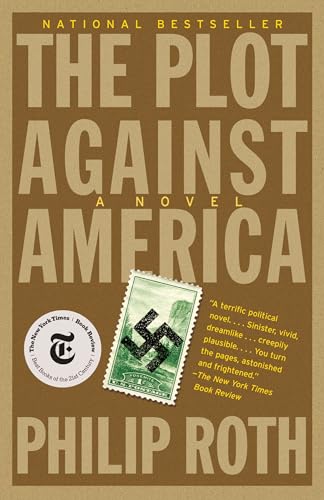Hey folks! Today, we are going to chat about “The Plot Against America.” This is not your usual history book, but an intriguing alternative history tale by Philip Roth. I had the pleasure of reading it, and let me tell you, it was a rollercoaster! Strap in for an honest review where we’ll discuss the book’s engaging ‘What if?’ scenarios, the political landscape, family dynamics, and character development. Buckle up because we’re in for a ride!
In a nutshell
The Plot Against America is written by Philip Roth. It’s a gripping alternative history novel. The book imagines an America where Charles Lindbergh, a Nazi sympathizer, becomes president. This change throws a Jewish family, including young Philip, into turmoil. Roth explores themes of fear, identity, and the fragility of democracy. The book resonates with the reader while exploring what-if scenarios. It is a must-read for history buffs and fans of political drama.
The Intriguing Concept of Alternative History
Have you ever wondered how the world might look if certain events happened differently? This is the essence of alternative history. It’s like a game of ‘What if?’ but on a grand scale. Imagine if Napoleon had a dinosaur army, or if Cleopatra ran a medieval Starbucks. These questions, although silly, highlight how alternative history can open a can of imagination worms that are hard to put back in!
One book that really puts its foot on the gas in this genre is The Plot Against America by Philip Roth. The author paints a very different United States, where Charles Lindbergh wins the presidency in 1940. When I read this book, I felt like I was riding a rollercoaster of ‘whoa, what if?’ twists, with each turn more jaw-dropping than the last. Roth’s narrative made my mental map of history do a loop-de-loop.
Pros? It’s gripping, thought-provoking, and Roth really knows how to make you bite your nails. Cons? Sometimes, the political jargon can feel like walking through knee-deep mud. But it’s worth the effort for how it ticks the ol’ brain gears. While reading, I couldn’t help but yell at the fictional version of history like I yell at the TV during a football game. Trust me, it’s that engaging!
The book is a brilliant reminder of how history is surprisingly malleable, and how those ‘What if?’ questions matter. It’s the perfect conversation starter for your next dinner party.
Coming up next, we’ll explore how Roth’s book delves into family and societal dynamics, proving that even in a twisted timeline, family drama is unavoidable!
Family and Societal Dynamics in ‘The Plot Against America’
‘The Plot Against America’ by Philip Roth presents a unique take on family and societal dynamics, set against an alternate historical backdrop. The plot revolves around the Levin family, who suddenly find their world turned upside down when Charles Lindbergh wins the presidency. Suddenly, the United States is led by a man with Nazi sympathies, adding layers of tension and fear to normal family life. The Levin family faces the challenge of staying united while society around them becomes increasingly hostile.
The dynamics in ‘The Plot Against America’ are quite layered. On one hand, you have the family’s struggle to maintain their cultural identity while dealing with prejudice and discrimination. I once had a heated family discussion (during Sunday barbecues, no less!) about identity and belonging, which this book beautifully mirrors. You hear the characters’ fears and hopes, and it hits home more than you’d think.
Society, meanwhile, shifts dramatically, forcing everyday Americans to face the complicated reality of bigotry and prejudice. Roth’s writing doesn’t shy away from showing how quickly neighbors can become enemies. It’s both compelling and chilling. From my own experience of neighborhood disputes over small things like garden fences, I’d say this book ramps it up tenfold!
Stay tuned as we explore how political changes impact this riveting tale, adding another layer of complexity in our next section: Political Landscape Exploration. Things are about to get more turbulent!
Political Landscape Exploration in ‘The Plot Against America’
When I cracked open ‘The Plot Against America,’ I was expecting a twisty alternate reality, but little did I know that Philip Roth would completely transport my imagination to a world where American politics take a wild turn. Buckle up, folks, because the book’s political landscape isn’t just a twist on history—it’s a whole rollercoaster ride.
In this alternative universe, Charles Lindbergh, the famous aviator, beats Franklin D. Roosevelt in the 1940 presidential election. The political tension is as thick as the peanut butter on my breakfast toast, and you feel the suspense in every page. The book explores a disturbing scenario where anti-Semitic policies creep into the government, and the fear is as real as a spider crawling on your arm. Historians might argue about probabilities, but Roth makes these political events feel uncannily plausible.
One of the best parts about this political exploration is how Roth weaves it into the everyday lives of an average Jewish family in Newark. His depiction of political impacts on individual lives is authentic and full of heart. However, for readers who aren’t political junkies like my friend Dave (the guy can talk politics until the cows come home), the political jargon might slow you down a bit. Don’t let that deter you, though—the fascinating politics make you think twice about the fragile line between reality and fiction.
Ready yourself for the next thrill in our review, because up next, we’re diving into the deep end of character development and realism, where Roth truly shows his magic.
Exploring Character Depth and Realism in ‘The Plot Against America’
Oh man, let me tell you, Philip Roth really knew how to cook up some characters in The Plot Against America. It’s like he took a regular family from your neighborhood and tossed them into a blender with some political chaos. I could almost hear my Aunt Edna’s voice in some of those dinner table arguments!
The Levin family, at the heart of this alternative history tale, is a perfect canvas for exploring themes of identity, fear, and resilience. Roth doesn’t just throw them into the storm; he makes sure we feel their anxiety as anti-Semitism creeps into their lives. Picture yourself sitting at the dinner table with them, as Dad cracks a bad joke while Mom silently worries about the future. These touches of realism make the book relatable and immersive.
Roth also adds depth to the supporting cast. Each character, even the minor ones, has quirks and flaws that breathe life into the story. I felt like I was eavesdropping on real-life conversations, filled with both humor and tension. This realism makes the reader ponder: How would I react if the world turned upside down? The characters’ journeys raise questions about morality and courage that stick with you long after the last page.
So, do I recommend taking ‘The Plot Against America’ for a spin? Absolutely! It’s well worth your time for its realistic characters and thought-provoking themes. Buckle up for a narrative rollercoaster that’s relatable, but also kinda makes you thankful for your own family drama. You’re gonna love it!
Conclusion
So, folks, that’s my review of ‘The Plot Against America.’ Roth’s knack for crafting relatable characters in a wacky yet chilling alternative history keeps us hooked. Despite some political jargon slowing the pace, the intriguing ‘What if?’ scenario is worth the read. Grab some popcorn and dive in—just without literally diving into the book. Happy reading!


